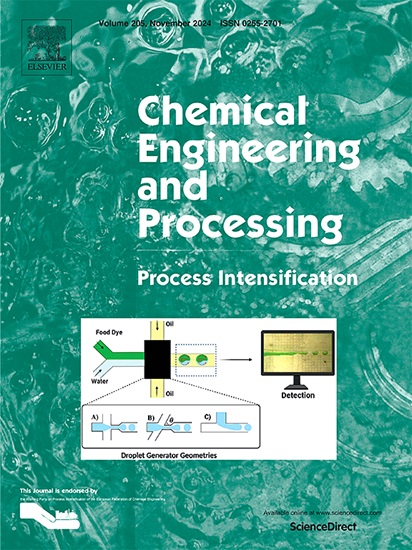Modeling and optimization of an integrated system for the green dimethyl ether production: Process simulation, modeling with artificial intelligence, and optimization methods
IF 3.8
3区 工程技术
Q3 ENERGY & FUELS
Chemical Engineering and Processing - Process Intensification
Pub Date : 2025-05-29
DOI:10.1016/j.cep.2025.110383
引用次数: 0
Abstract
Green dimethyl ether is emerging as a promising alternative fuel due to its environmental benefits and potential integration into carbon-neutral energy systems. This study presents a comprehensive workflow for modeling, simulation, and optimization of green dimethyl ether production using an integrated approach that combines artificial neural networks and multi-objective optimization. Process simulation in Aspen Plus was employed to model key units, including methanol synthesis, CO2 capture, desalination, electrolysis, and cogeneration. Artificial neural networks were trained to predict system performance, achieving high accuracy across multiple process units. A comparative analysis of deterministic, Bayesian, and metaheuristic optimization approaches showed that deterministic optimization offered the best balance between economic feasibility and energy efficiency. The optimized configuration achieved a green dimethyl ether production rate of 3035.7 kg/h, reducing total annual costs and energy consumption. These findings highlight the effectiveness of AI-driven optimization in enhancing sustainable fuel production. The proposed methodology contributes to the transition toward a low-carbon economy by improving green dimethyl ether process efficiency and economic viability.

绿色二甲醚生产集成系统建模与优化:过程仿真、人工智能建模与优化方法
绿色二甲醚由于其环境效益和与碳中和能源系统的潜在整合,正成为一种有前途的替代燃料。本研究采用人工神经网络和多目标优化相结合的综合方法,提出了绿色二甲醚生产的建模、仿真和优化的综合工作流程。利用Aspen Plus中的过程模拟对关键单元进行建模,包括甲醇合成、二氧化碳捕获、海水淡化、电解和热电联产。通过训练人工神经网络来预测系统性能,实现跨多个过程单元的高精度。对确定性优化、贝叶斯优化和元启发式优化方法的比较分析表明,确定性优化在经济可行性和能源效率之间提供了最佳平衡。优化配置后,绿色二甲醚产量达到3035.7 kg/h,降低了年总成本和能耗。这些发现突出了人工智能驱动的优化在提高可持续燃料生产方面的有效性。所提出的方法通过提高绿色二甲醚工艺效率和经济可行性,有助于向低碳经济过渡。
本文章由计算机程序翻译,如有差异,请以英文原文为准。
求助全文
约1分钟内获得全文
求助全文
来源期刊
CiteScore
7.80
自引率
9.30%
发文量
408
审稿时长
49 days
期刊介绍:
Chemical Engineering and Processing: Process Intensification is intended for practicing researchers in industry and academia, working in the field of Process Engineering and related to the subject of Process Intensification.Articles published in the Journal demonstrate how novel discoveries, developments and theories in the field of Process Engineering and in particular Process Intensification may be used for analysis and design of innovative equipment and processing methods with substantially improved sustainability, efficiency and environmental performance.

 求助内容:
求助内容: 应助结果提醒方式:
应助结果提醒方式:


